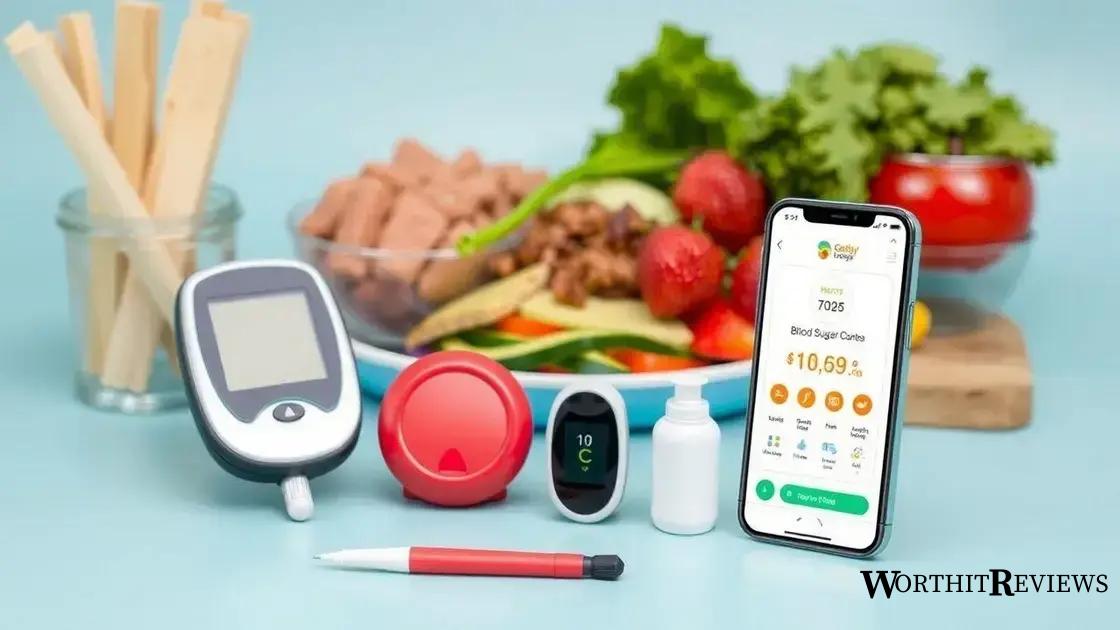Managing type two diabetes involves maintaining stable sugar levels through a balanced diet, regular exercise, and proper medication, critical for preventing complications and ensuring overall health.
When it comes to type two diabetes sugar levels, understanding what they mean is crucial for your health. You may wonder how daily choices affect your body, and that’s a great question to explore!
Understanding type two diabetes and sugar levels
Understanding type two diabetes and how it affects sugar levels is essential for managing this condition. In type two diabetes, the body either resists the effects of insulin or doesn’t produce enough insulin to maintain normal glucose levels.
What Are Sugar Levels?
Sugar levels, or blood glucose levels, indicate how much glucose is present in your bloodstream. For individuals with type two diabetes, these levels can fluctuate greatly depending on diet, activity, and overall health. Regular monitoring can help keep track of these readings.
Normal vs. Diabetic Sugar Levels
A normal blood sugar level is generally below 100 mg/dL when fasting. In contrast, levels for someone living with type two diabetes may run higher. Understanding these differences is crucial in preventing complications that can arise from uncontrolled sugar levels.
How the Body Regulates Sugar Levels
The pancreas plays a vital role in regulating sugar levels by producing insulin. Insulin helps cells take in glucose for energy. However, when the body develops insulin resistance, glucose levels can rise, leading to various health issues.
Common Symptoms of High Sugar Levels
Symptoms of high sugar levels include increased thirst, frequent urination, and fatigue. Long-term, high sugar levels can lead to serious health complications such as heart disease and kidney damage. Recognizing these symptoms early is crucial for effective management.
Importance of Monitoring
Regularly checking your blood sugar levels is important. It allows you to see how your food, activity, and medications affect your sugar levels. This information is key to making informed decisions about your health.
The importance of monitoring your sugar levels

Monitoring your sugar levels is essential for anyone with type two diabetes. Keeping track of blood glucose levels can help you make informed choices about your diet, exercise, and medication.
Why Monitoring Is Crucial
When you regularly check your sugar levels, you gain insight into how your body responds to various foods and activities. This is vital for preventing both high and low blood sugar episodes, which can have serious health consequences.
How Often Should You Check?
For many, testing sugar levels multiple times a day is recommended. Your healthcare provider can help determine a personalized plan based on your individual needs.
Tools for Monitoring
Various tools are available for monitoring blood sugar. Glucose meters, continuous glucose monitors (CGMs), and even mobile apps can help you track your levels easily and effectively.
Using Data to Make Decisions
When you monitor your sugar levels, you gather valuable data. This information can be used to adjust your diet or exercise routines and to communicate better with your healthcare team.
Staying Empowered
Regular monitoring empowers you to take charge of your health. It helps you identify patterns, make necessary adjustments, and ultimately achieve better management of your diabetes.
How diet impacts sugar levels in type two diabetes
Your diet plays a significant role in managing type two diabetes. The foods you choose can directly impact your blood sugar levels and overall health.
Understanding Carbohydrates
Carbohydrates are a major contributor to blood sugar levels. Foods high in refined carbs, such as white bread and sugary snacks, can cause spikes in glucose. On the other hand, whole grains and fiber-rich foods help maintain stable sugar levels.
The Role of Fiber
Fiber is essential in managing sugar levels because it slows down the digestion of carbohydrates. Foods rich in fiber include fruits, vegetables, whole grains, and legumes. Incorporating these foods into your diet can improve blood sugar control.
Importance of Portion Control
Portion control is crucial for managing your diet. Eating large portions, even of healthy foods, can lead to increased blood sugar levels. Using smaller plates and measuring servings can help you keep portions in check.
Protein and Healthy Fats
Including protein and healthy fats in your meals can aid in stabilizing blood sugar levels. Lean meats, fish, nuts, and avocados are great options. They provide nutrients without the high carb content that could elevate sugar levels.
Meal Timing
How often you eat also matters. Skipping meals can cause your blood sugar to drop too low, while eating too frequently or snacking can lead to higher levels. Finding a consistent meal schedule that works for you is vital.
Exercise: a crucial factor in sugar management

Exercise is a crucial factor in managing type two diabetes. Regular physical activity helps control blood sugar levels, boosts insulin sensitivity, and improves overall health.
Benefits of Regular Exercise
Engaging in routine exercise helps lower blood sugar levels by allowing your muscles to use glucose for energy. This process can lead to weight loss, improved cardiovascular health, and better mood.
Types of Exercises to Consider
There are many types of exercises beneficial for managing diabetes. Aerobic activities, such as walking, swimming, and cycling, are great for improving heart health. Strength training can also be effective by building muscle mass, which aids in glucose uptake.
How Often Should You Exercise?
Experts recommend aiming for at least 150 minutes of moderate-intensity aerobic activity each week, combined with strength training on two or more days. This balance provides wide-ranging benefits for blood sugar control.
Staying Active Throughout the Day
In addition to structured workouts, find ways to be active throughout the day. Simple actions, like taking the stairs instead of the elevator or doing yard work, can significantly contribute to overall activity levels.
Tips for Getting Started
If you’re new to exercising, start slowly and gradually increase your activity. Consult with your healthcare provider to create a safe and effective exercise plan tailored to your needs.
The role of medication in controlling sugar levels
Medication plays a vital role in controlling blood sugar levels for individuals with type two diabetes. Understanding the types of medications available can help you manage your condition more effectively.
Types of Medications
There are several types of medications used to manage blood sugar levels. Metformin is often the first medication prescribed. It helps lower glucose production in the liver and improves insulin sensitivity.
Other Oral Medications
In addition to metformin, there are other oral medications like SGLT2 inhibitors and DPP-4 inhibitors. SGLT2 inhibitors help the kidneys remove glucose through urine, while DPP-4 inhibitors increase insulin production and decrease glucose production.
Insulin Therapy
Some individuals with type two diabetes may need insulin therapy, especially if blood sugar levels are not well-controlled with oral medications. Insulin helps the body use glucose for energy and is essential for those with significant insulin resistance.
Understanding Side Effects
Every medication can have side effects. It’s essential to discuss potential side effects with your healthcare provider. Common side effects may include weight gain, gastrointestinal issues, or low blood sugar episodes.
Regular Monitoring and Adjustments
Regular monitoring of blood sugar levels is crucial for adjusting medications as needed. Your healthcare team can help you determine the best approach based on your unique health needs and lifestyle.
Tips for maintaining stable sugar levels daily

Maintaining stable sugar levels daily is essential for managing type two diabetes. Here are some effective tips to help you achieve this goal.
Follow a Balanced Diet
A balanced diet is key to keeping your blood sugar levels stable. Focus on eating whole grains, lean proteins, healthy fats, and plenty of fruits and vegetables. Avoid processed foods and sugary snacks that can spike your blood sugar.
Portion Control
Control your portion sizes to help manage your intake of carbohydrates. Larger portions can lead to higher blood sugar levels. Using smaller plates and measuring portions can be beneficial.
Stay Hydrated
Drinking plenty of water throughout the day can help keep your blood sugar levels in check. Staying hydrated helps your kidneys flush out excess sugar through urine.
Regular Exercise
Incorporating regular physical activity into your routine can greatly improve your blood sugar control. Aim for at least 150 minutes of moderate exercise each week, such as walking, swimming, or cycling.
Monitor Your Blood Sugar
Regularly monitoring your blood sugar levels can help you identify patterns and manage your diabetes effectively. Keeping a log of your readings can provide important insights to share with your healthcare provider.
Consistent Meal Timing
Eating your meals at consistent times helps regulate your body’s insulin response. Try to avoid skipping meals, and aim for balanced meals and snacks throughout the day.
Managing Type Two Diabetes for a Healthier Life
In summary, effectively managing type two diabetes involves a combination of balanced nutrition, regular exercise, and proper medication. By understanding how diet impacts sugar levels and incorporating daily physical activity, you can maintain stable blood sugar levels.
Monitoring your health regularly and following the tips provided will empower you to take control of your diabetes. Remember, each small step you take can lead to significant improvements in your overall well-being.
With determination and support, you can navigate the challenges of diabetes and live a healthier, more fulfilling life.
FAQ – Frequently Asked Questions about Managing Type Two Diabetes
What dietary changes can help stabilize my blood sugar levels?
Eating a balanced diet rich in whole grains, lean proteins, and healthy fats, while avoiding sugary snacks, can greatly stabilize your blood sugar.
How often should I exercise to manage type two diabetes?
Aim for at least 150 minutes of moderate exercise each week, such as walking or cycling, to help control blood sugar levels.
What role does medication play in managing my diabetes?
Medication, like metformin, can help manage blood sugar levels when diet and exercise alone are not enough.
How can I effectively monitor my blood sugar levels?
Regularly checking your blood sugar with a glucose meter helps you understand how food and activities affect your levels.
What should I do if my blood sugar levels are too high or too low?
If your blood sugar is high, drink water and engage in light activity. If it’s low, consume quick-acting carbohydrates like fruit juice or glucose tablets.
Why is hydration important for diabetes management?
Staying hydrated helps your kidneys flush out excess sugar and can aid in maintaining stable blood sugar levels.
